Auditing and Assurance Assignment: Risk and Financial Analysis
VerifiedAdded on 2020/03/04
|5
|1266
|52
Homework Assignment
AI Summary
This auditing and assurance assignment analyzes a company's financial statements, focusing on risk assessment and audit planning. It examines the impact of accounting policy changes, such as the discontinuation of inventory obsolescence provisions and changes to asset useful lives, on audit procedures. The assignment identifies inherent risks, including content obsolescence in the ebook business and the decline in demand for print-on-demand services. It also explores potential fraud risks related to revenue recognition, inventory valuation, and the manipulation of financial ratios. The analysis emphasizes the need for specific audit procedures to address these risks, including testing for inventory obsolescence, verifying revenue recognition, and assessing the impact of management's decisions on financial reporting. The assignment refers to relevant auditing standards and provides recommendations for a comprehensive audit strategy.
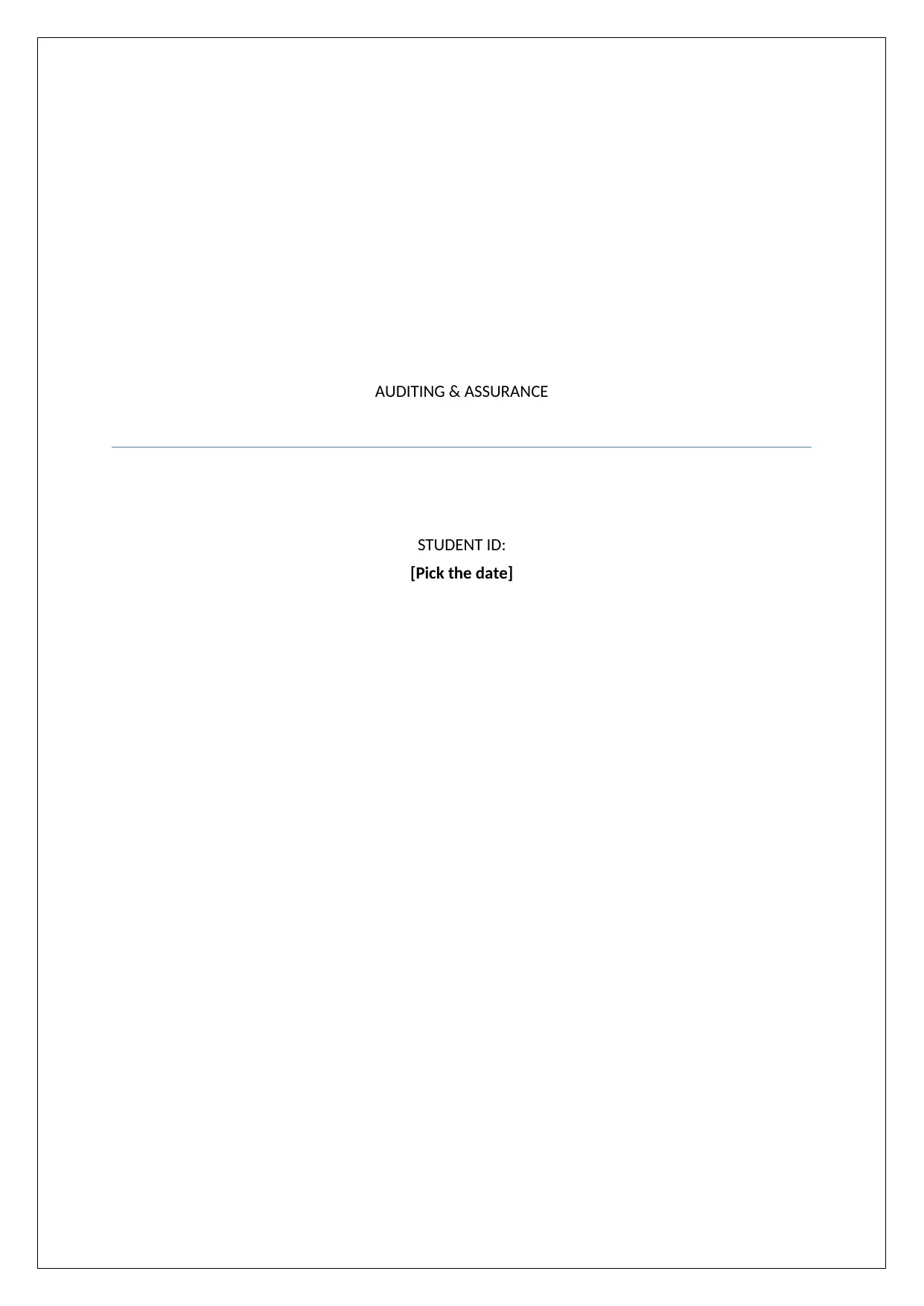
AUDITING & ASSURANCE
STUDENT ID:
[Pick the date]
STUDENT ID:
[Pick the date]
Paraphrase This Document
Need a fresh take? Get an instant paraphrase of this document with our AI Paraphraser
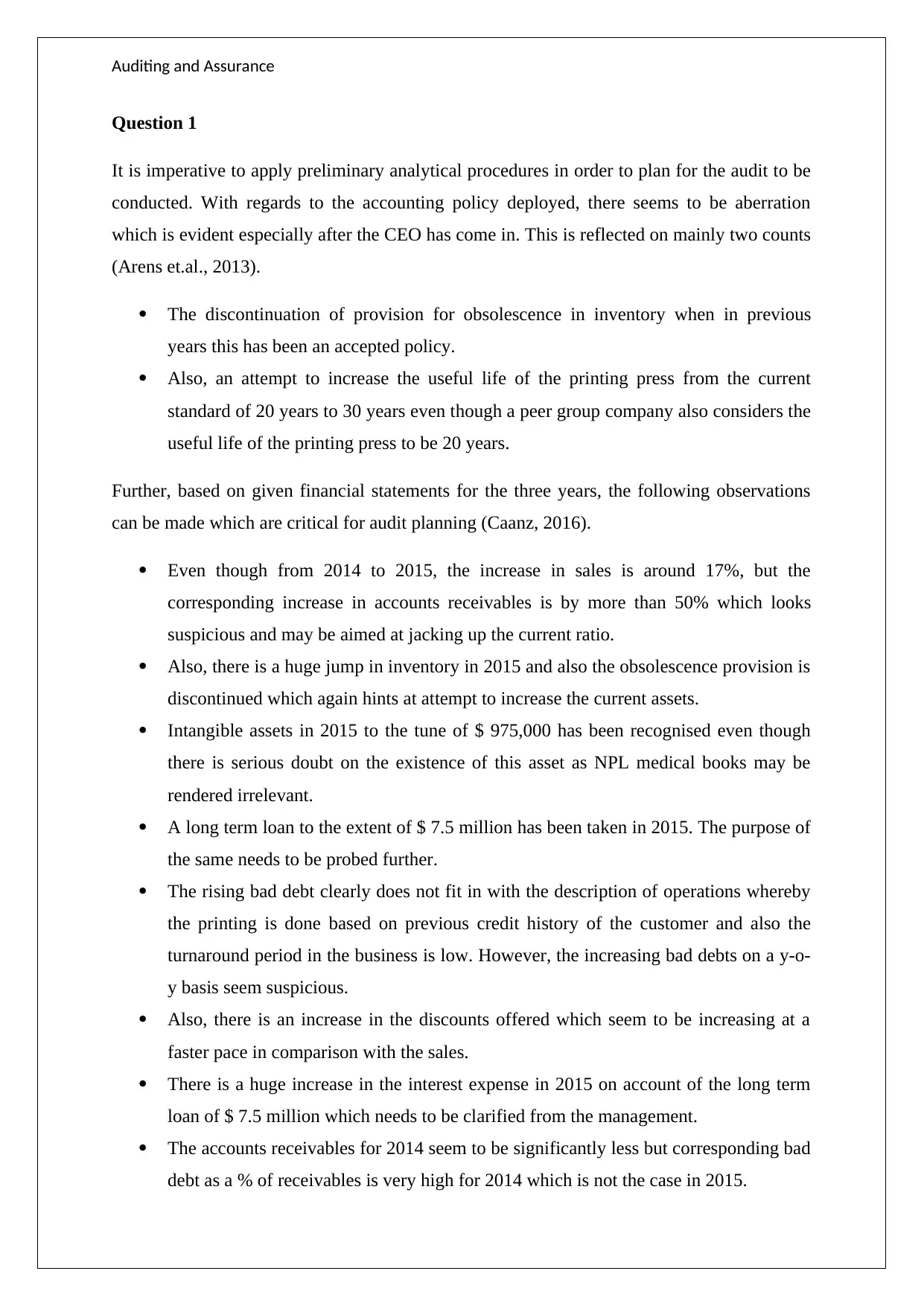
Auditing and Assurance
Question 1
It is imperative to apply preliminary analytical procedures in order to plan for the audit to be
conducted. With regards to the accounting policy deployed, there seems to be aberration
which is evident especially after the CEO has come in. This is reflected on mainly two counts
(Arens et.al., 2013).
The discontinuation of provision for obsolescence in inventory when in previous
years this has been an accepted policy.
Also, an attempt to increase the useful life of the printing press from the current
standard of 20 years to 30 years even though a peer group company also considers the
useful life of the printing press to be 20 years.
Further, based on given financial statements for the three years, the following observations
can be made which are critical for audit planning (Caanz, 2016).
Even though from 2014 to 2015, the increase in sales is around 17%, but the
corresponding increase in accounts receivables is by more than 50% which looks
suspicious and may be aimed at jacking up the current ratio.
Also, there is a huge jump in inventory in 2015 and also the obsolescence provision is
discontinued which again hints at attempt to increase the current assets.
Intangible assets in 2015 to the tune of $ 975,000 has been recognised even though
there is serious doubt on the existence of this asset as NPL medical books may be
rendered irrelevant.
A long term loan to the extent of $ 7.5 million has been taken in 2015. The purpose of
the same needs to be probed further.
The rising bad debt clearly does not fit in with the description of operations whereby
the printing is done based on previous credit history of the customer and also the
turnaround period in the business is low. However, the increasing bad debts on a y-o-
y basis seem suspicious.
Also, there is an increase in the discounts offered which seem to be increasing at a
faster pace in comparison with the sales.
There is a huge increase in the interest expense in 2015 on account of the long term
loan of $ 7.5 million which needs to be clarified from the management.
The accounts receivables for 2014 seem to be significantly less but corresponding bad
debt as a % of receivables is very high for 2014 which is not the case in 2015.
Question 1
It is imperative to apply preliminary analytical procedures in order to plan for the audit to be
conducted. With regards to the accounting policy deployed, there seems to be aberration
which is evident especially after the CEO has come in. This is reflected on mainly two counts
(Arens et.al., 2013).
The discontinuation of provision for obsolescence in inventory when in previous
years this has been an accepted policy.
Also, an attempt to increase the useful life of the printing press from the current
standard of 20 years to 30 years even though a peer group company also considers the
useful life of the printing press to be 20 years.
Further, based on given financial statements for the three years, the following observations
can be made which are critical for audit planning (Caanz, 2016).
Even though from 2014 to 2015, the increase in sales is around 17%, but the
corresponding increase in accounts receivables is by more than 50% which looks
suspicious and may be aimed at jacking up the current ratio.
Also, there is a huge jump in inventory in 2015 and also the obsolescence provision is
discontinued which again hints at attempt to increase the current assets.
Intangible assets in 2015 to the tune of $ 975,000 has been recognised even though
there is serious doubt on the existence of this asset as NPL medical books may be
rendered irrelevant.
A long term loan to the extent of $ 7.5 million has been taken in 2015. The purpose of
the same needs to be probed further.
The rising bad debt clearly does not fit in with the description of operations whereby
the printing is done based on previous credit history of the customer and also the
turnaround period in the business is low. However, the increasing bad debts on a y-o-
y basis seem suspicious.
Also, there is an increase in the discounts offered which seem to be increasing at a
faster pace in comparison with the sales.
There is a huge increase in the interest expense in 2015 on account of the long term
loan of $ 7.5 million which needs to be clarified from the management.
The accounts receivables for 2014 seem to be significantly less but corresponding bad
debt as a % of receivables is very high for 2014 which is not the case in 2015.
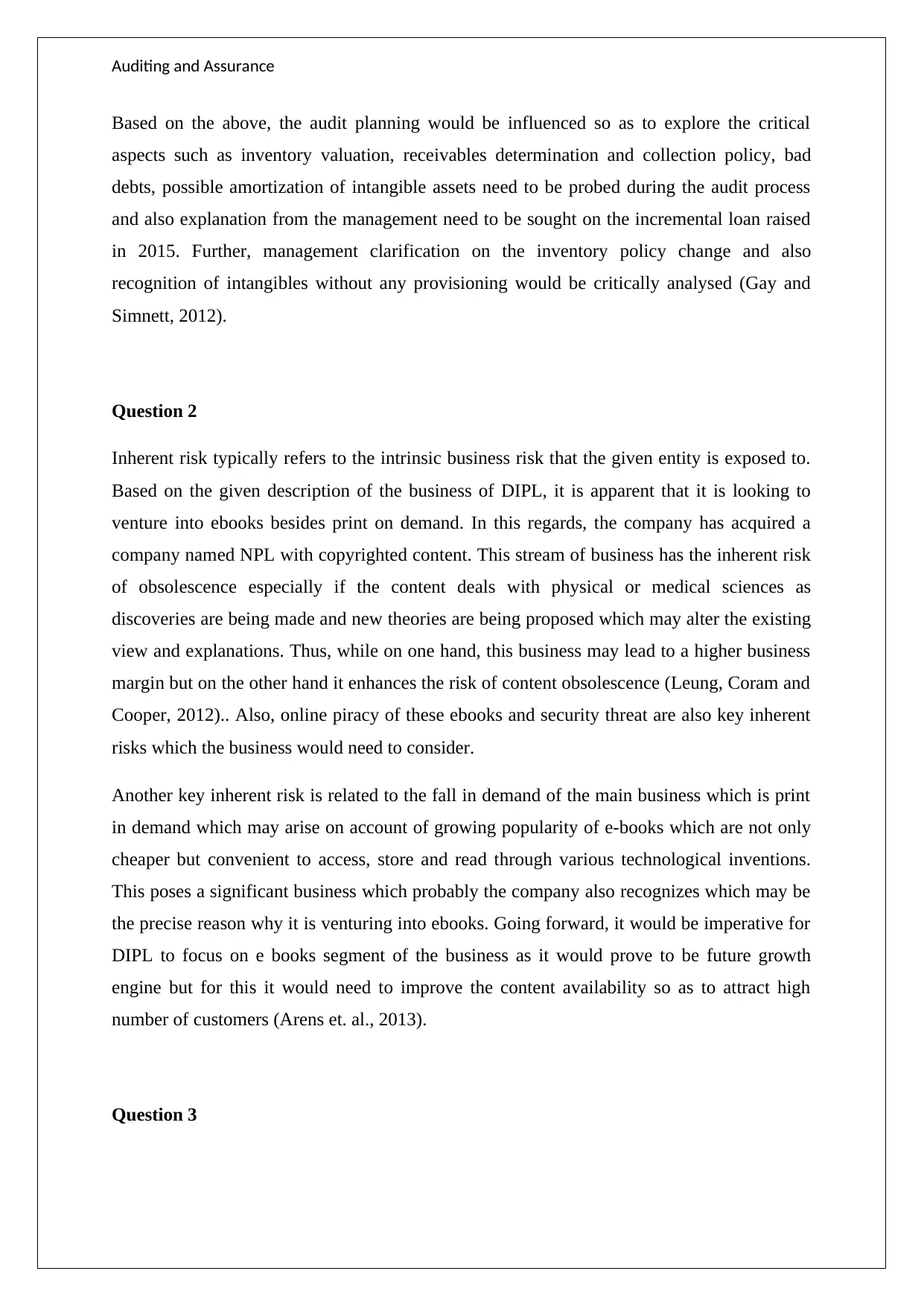
Auditing and Assurance
Based on the above, the audit planning would be influenced so as to explore the critical
aspects such as inventory valuation, receivables determination and collection policy, bad
debts, possible amortization of intangible assets need to be probed during the audit process
and also explanation from the management need to be sought on the incremental loan raised
in 2015. Further, management clarification on the inventory policy change and also
recognition of intangibles without any provisioning would be critically analysed (Gay and
Simnett, 2012).
Question 2
Inherent risk typically refers to the intrinsic business risk that the given entity is exposed to.
Based on the given description of the business of DIPL, it is apparent that it is looking to
venture into ebooks besides print on demand. In this regards, the company has acquired a
company named NPL with copyrighted content. This stream of business has the inherent risk
of obsolescence especially if the content deals with physical or medical sciences as
discoveries are being made and new theories are being proposed which may alter the existing
view and explanations. Thus, while on one hand, this business may lead to a higher business
margin but on the other hand it enhances the risk of content obsolescence (Leung, Coram and
Cooper, 2012).. Also, online piracy of these ebooks and security threat are also key inherent
risks which the business would need to consider.
Another key inherent risk is related to the fall in demand of the main business which is print
in demand which may arise on account of growing popularity of e-books which are not only
cheaper but convenient to access, store and read through various technological inventions.
This poses a significant business which probably the company also recognizes which may be
the precise reason why it is venturing into ebooks. Going forward, it would be imperative for
DIPL to focus on e books segment of the business as it would prove to be future growth
engine but for this it would need to improve the content availability so as to attract high
number of customers (Arens et. al., 2013).
Question 3
Based on the above, the audit planning would be influenced so as to explore the critical
aspects such as inventory valuation, receivables determination and collection policy, bad
debts, possible amortization of intangible assets need to be probed during the audit process
and also explanation from the management need to be sought on the incremental loan raised
in 2015. Further, management clarification on the inventory policy change and also
recognition of intangibles without any provisioning would be critically analysed (Gay and
Simnett, 2012).
Question 2
Inherent risk typically refers to the intrinsic business risk that the given entity is exposed to.
Based on the given description of the business of DIPL, it is apparent that it is looking to
venture into ebooks besides print on demand. In this regards, the company has acquired a
company named NPL with copyrighted content. This stream of business has the inherent risk
of obsolescence especially if the content deals with physical or medical sciences as
discoveries are being made and new theories are being proposed which may alter the existing
view and explanations. Thus, while on one hand, this business may lead to a higher business
margin but on the other hand it enhances the risk of content obsolescence (Leung, Coram and
Cooper, 2012).. Also, online piracy of these ebooks and security threat are also key inherent
risks which the business would need to consider.
Another key inherent risk is related to the fall in demand of the main business which is print
in demand which may arise on account of growing popularity of e-books which are not only
cheaper but convenient to access, store and read through various technological inventions.
This poses a significant business which probably the company also recognizes which may be
the precise reason why it is venturing into ebooks. Going forward, it would be imperative for
DIPL to focus on e books segment of the business as it would prove to be future growth
engine but for this it would need to improve the content availability so as to attract high
number of customers (Arens et. al., 2013).
Question 3
⊘ This is a preview!⊘
Do you want full access?
Subscribe today to unlock all pages.

Trusted by 1+ million students worldwide
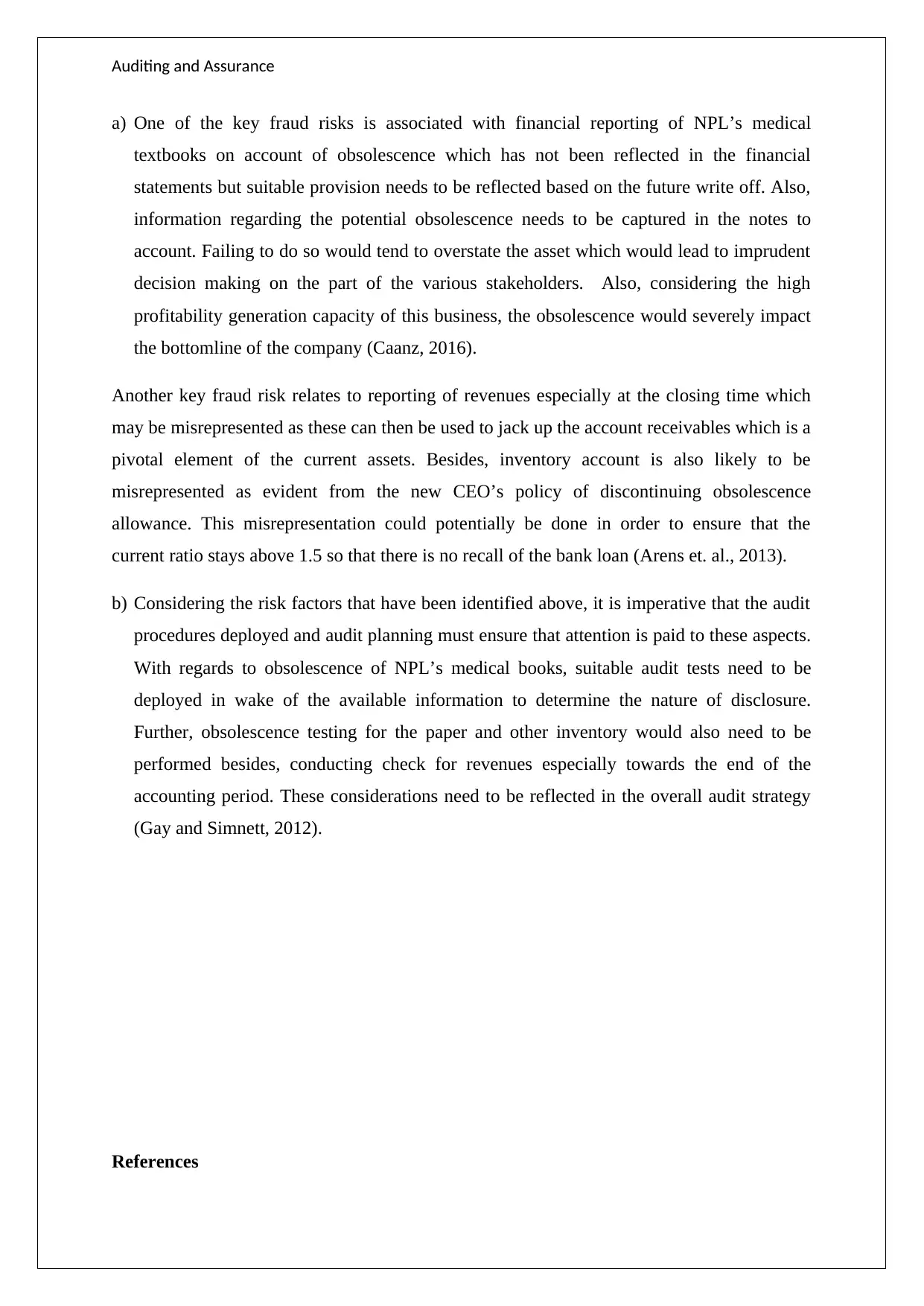
Auditing and Assurance
a) One of the key fraud risks is associated with financial reporting of NPL’s medical
textbooks on account of obsolescence which has not been reflected in the financial
statements but suitable provision needs to be reflected based on the future write off. Also,
information regarding the potential obsolescence needs to be captured in the notes to
account. Failing to do so would tend to overstate the asset which would lead to imprudent
decision making on the part of the various stakeholders. Also, considering the high
profitability generation capacity of this business, the obsolescence would severely impact
the bottomline of the company (Caanz, 2016).
Another key fraud risk relates to reporting of revenues especially at the closing time which
may be misrepresented as these can then be used to jack up the account receivables which is a
pivotal element of the current assets. Besides, inventory account is also likely to be
misrepresented as evident from the new CEO’s policy of discontinuing obsolescence
allowance. This misrepresentation could potentially be done in order to ensure that the
current ratio stays above 1.5 so that there is no recall of the bank loan (Arens et. al., 2013).
b) Considering the risk factors that have been identified above, it is imperative that the audit
procedures deployed and audit planning must ensure that attention is paid to these aspects.
With regards to obsolescence of NPL’s medical books, suitable audit tests need to be
deployed in wake of the available information to determine the nature of disclosure.
Further, obsolescence testing for the paper and other inventory would also need to be
performed besides, conducting check for revenues especially towards the end of the
accounting period. These considerations need to be reflected in the overall audit strategy
(Gay and Simnett, 2012).
References
a) One of the key fraud risks is associated with financial reporting of NPL’s medical
textbooks on account of obsolescence which has not been reflected in the financial
statements but suitable provision needs to be reflected based on the future write off. Also,
information regarding the potential obsolescence needs to be captured in the notes to
account. Failing to do so would tend to overstate the asset which would lead to imprudent
decision making on the part of the various stakeholders. Also, considering the high
profitability generation capacity of this business, the obsolescence would severely impact
the bottomline of the company (Caanz, 2016).
Another key fraud risk relates to reporting of revenues especially at the closing time which
may be misrepresented as these can then be used to jack up the account receivables which is a
pivotal element of the current assets. Besides, inventory account is also likely to be
misrepresented as evident from the new CEO’s policy of discontinuing obsolescence
allowance. This misrepresentation could potentially be done in order to ensure that the
current ratio stays above 1.5 so that there is no recall of the bank loan (Arens et. al., 2013).
b) Considering the risk factors that have been identified above, it is imperative that the audit
procedures deployed and audit planning must ensure that attention is paid to these aspects.
With regards to obsolescence of NPL’s medical books, suitable audit tests need to be
deployed in wake of the available information to determine the nature of disclosure.
Further, obsolescence testing for the paper and other inventory would also need to be
performed besides, conducting check for revenues especially towards the end of the
accounting period. These considerations need to be reflected in the overall audit strategy
(Gay and Simnett, 2012).
References
Paraphrase This Document
Need a fresh take? Get an instant paraphrase of this document with our AI Paraphraser
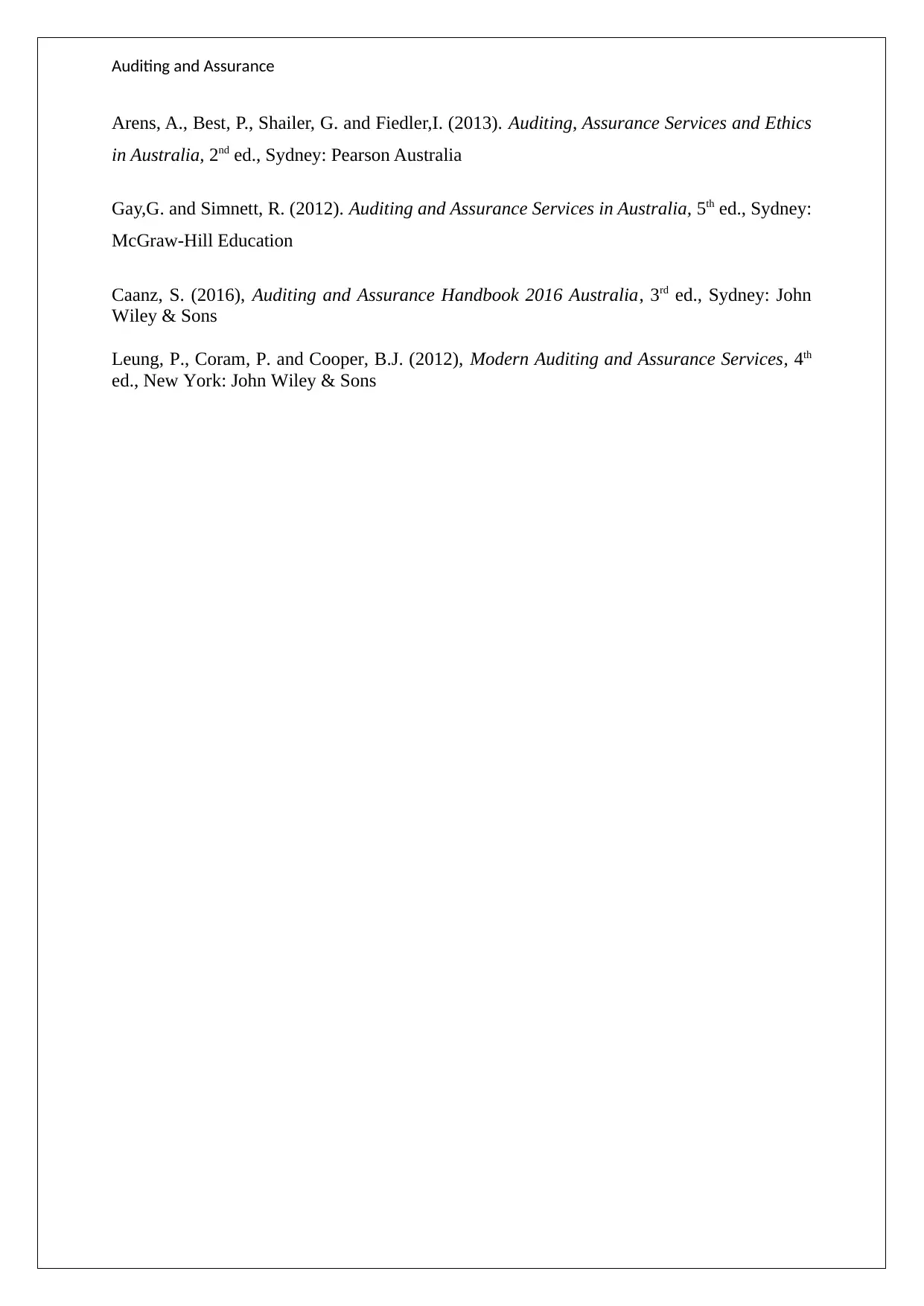
Auditing and Assurance
Arens, A., Best, P., Shailer, G. and Fiedler,I. (2013). Auditing, Assurance Services and Ethics
in Australia, 2nd ed., Sydney: Pearson Australia
Gay,G. and Simnett, R. (2012). Auditing and Assurance Services in Australia, 5th ed., Sydney:
McGraw-Hill Education
Caanz, S. (2016), Auditing and Assurance Handbook 2016 Australia, 3rd ed., Sydney: John
Wiley & Sons
Leung, P., Coram, P. and Cooper, B.J. (2012), Modern Auditing and Assurance Services, 4th
ed., New York: John Wiley & Sons
Arens, A., Best, P., Shailer, G. and Fiedler,I. (2013). Auditing, Assurance Services and Ethics
in Australia, 2nd ed., Sydney: Pearson Australia
Gay,G. and Simnett, R. (2012). Auditing and Assurance Services in Australia, 5th ed., Sydney:
McGraw-Hill Education
Caanz, S. (2016), Auditing and Assurance Handbook 2016 Australia, 3rd ed., Sydney: John
Wiley & Sons
Leung, P., Coram, P. and Cooper, B.J. (2012), Modern Auditing and Assurance Services, 4th
ed., New York: John Wiley & Sons
1 out of 5
Related Documents
Your All-in-One AI-Powered Toolkit for Academic Success.
+13062052269
info@desklib.com
Available 24*7 on WhatsApp / Email
![[object Object]](/_next/static/media/star-bottom.7253800d.svg)
Unlock your academic potential
Copyright © 2020–2025 A2Z Services. All Rights Reserved. Developed and managed by ZUCOL.




